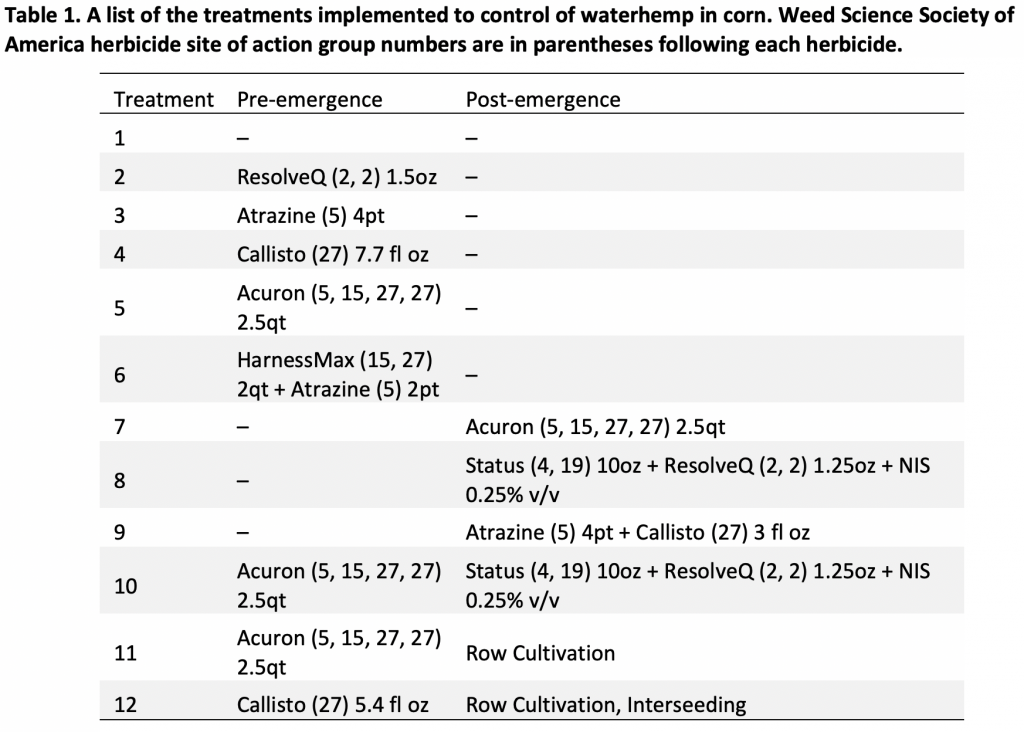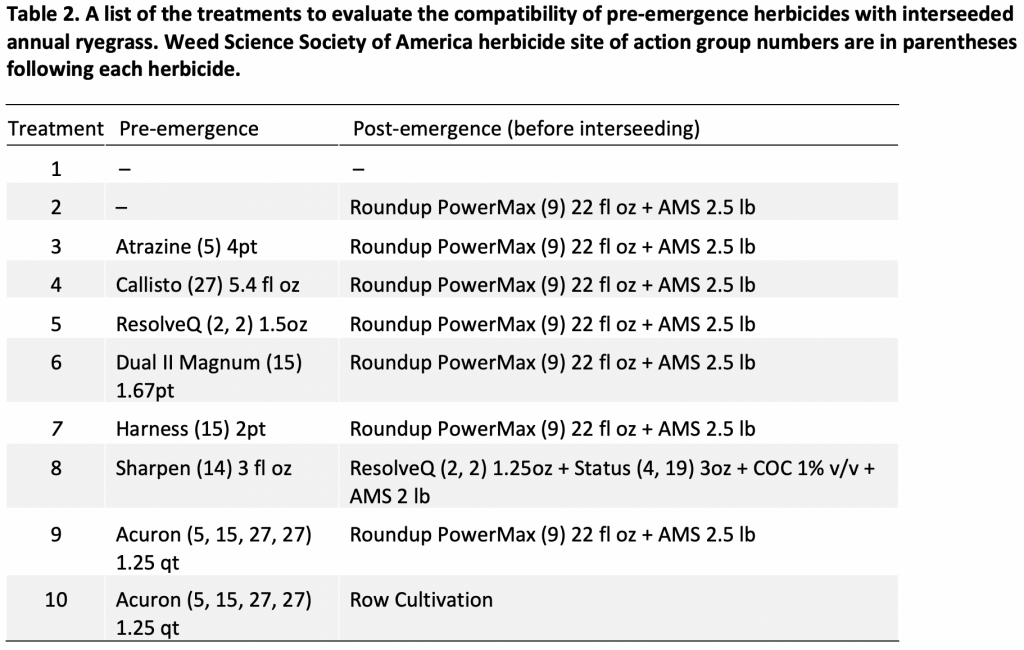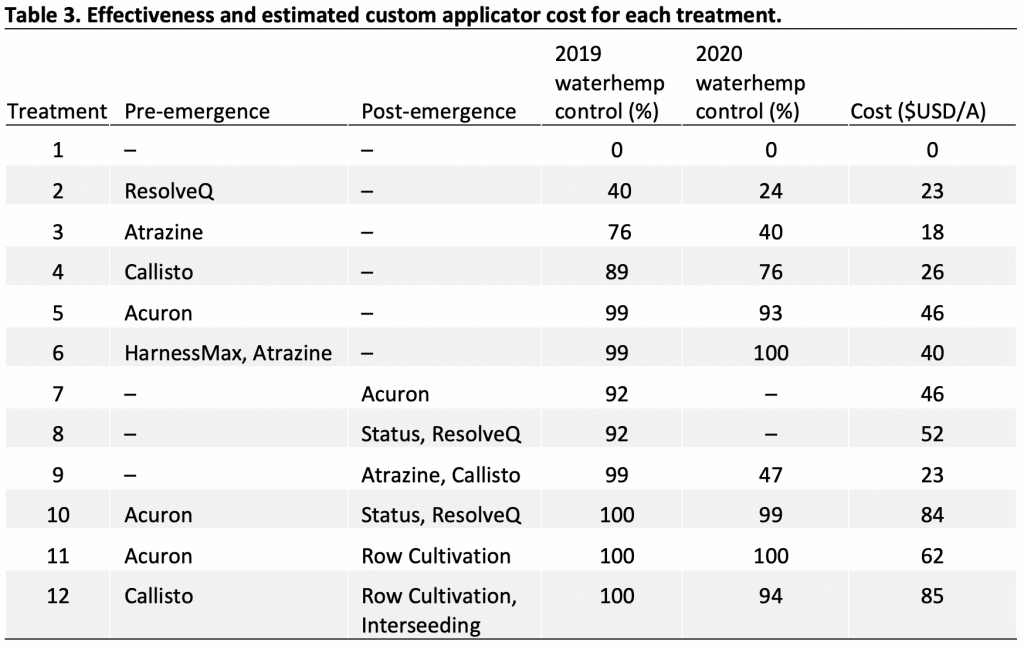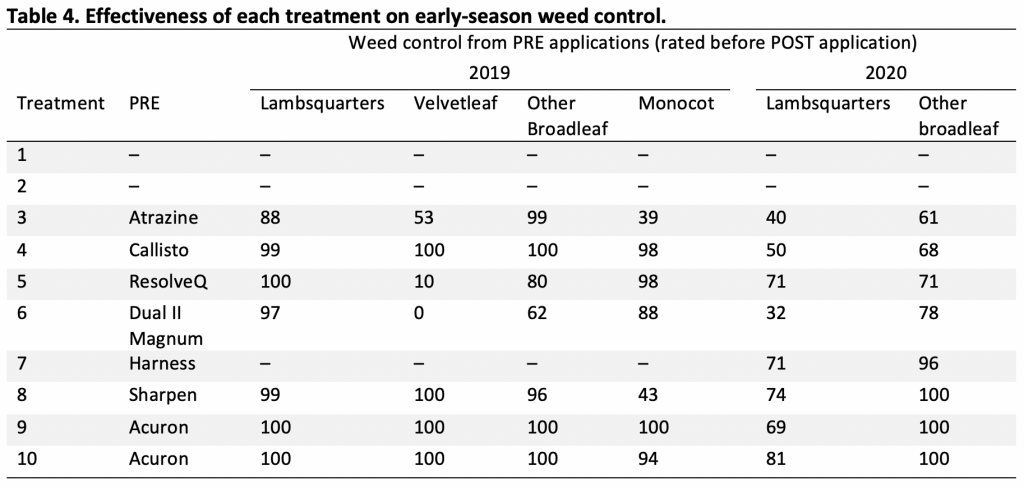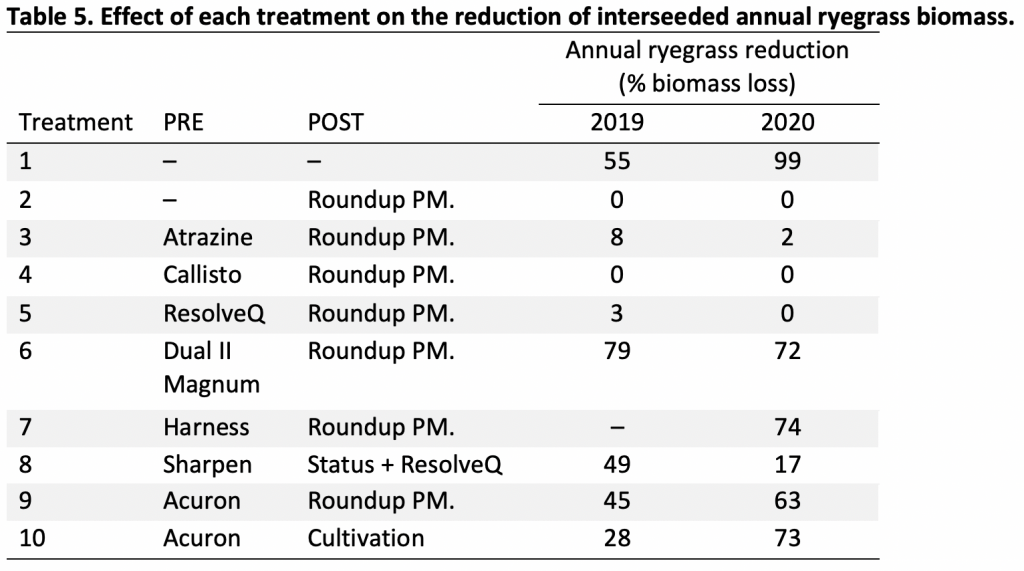Project Leaders
Bryan Brown, NYS IPM Program
Venancio Fernandez, Bayer Crop Sciences
Mike Hunter, Cornell Cooperative Extension
Jeff Miller, Oneida County Cooperative Extension
Mike Stanyard, Cornell Cooperative Extension
Cooperators
Derek Conway, Conway Farms
Jaime Cummings, formerly NYS IPM Program
Quentin Good, Quentin Good Farms
Antonio DiTommaso, Cornell University
Michael Durant, Lewis County Soil and Water Conservation District
Scott Morris, Cornell University
Ali Nafchi, Cornell Cooperative Extension
Ryan Parker, NYS IPM Program
Jodi Putman, Cornell Cooperative Extension
Joshua Putman, Cornell Cooperative Extension
Matthew Ryan, Cornell University
Lynn Sosnoskie, Cornell University
Ken Wise, NYS IPM Program
Funding Sources
New York Farm Viability Institute
Project Location
Trial locations in Seneca and Oneida Counties but results are likely applicable statewide.
Abstract
Herbicide resistant tall waterhemp (Amaranthus tuberculatus) continues to be one of the most problematic weeds in US field crops. Thus far, it has primarily established in western and central New York. Our second year of trial results generally followed our first-year results. Herbicides in WSSA groups 2, 5, and 9 should not be relied on for waterhemp control. However, programs that included at least two non-chemical tactics or herbicides from groups 4, 14, 15, 19, or 27 were very effective. Seedbank modelling showed that control at 95%, 98%, or 100% would cause waterhemp emergence to increase, maintain, or decrease over time, respectively. Interseeding annual ryegrass in fields where waterhemp has established is not recommended, but Callisto provided acceptable control of waterhemp while not injuring the annual ryegrass.
Background and Justification
Herbicide resistant waterhemp has been reported in many western and central NY counties. Corn farmers have reported yield losses of 20% due to this weed, even after herbicide applications. Our greenhouse spray chamber tests and field trials from 2019 suggest resistance to WSSA herbicide groups 2, 5, and 9 (ALS inhibitors, photosystem II inhibitors, and EPSPS inhibitors, respectively). Our most effective control programs in 2019 relied on herbicides from other groups as well as additional physical or cultural tactics. Generally, two-pass programs with residual activity were best. But residual herbicides can injure interseeded cover crops, which have grown in popularity in NY, reflecting the work of the Western NY Soil Health Alliance and the Genesee River Coalition of Conservation Districts.
Objectives
Objective 1. Continue to evaluate the effectiveness of several different programs in controlling waterhemp in corn.
Objective 2. Continue to assess the compatibility of residual herbicides with an interseeded cover crop.
Procedures
Objective 1.
The trial site was in Seneca County, NY on a field of Odessa silt loam soil where waterhemp had survived various herbicide applications and produced seed in 2018 and was moderately controlled in 2019 in corn. In 2020, the ground was prepared for planting with a field cultivator on May 5 and planted on May 13. Pre-emergence applications were made after planting on May 20. Cultivation and interseeding occurred on June 16, while the other post-emergence treatments were applied on June 18. All treatments are listed in Table 1. For fertilizer, DAP (10-46-0, 20 lbs N/A, 92 lbs P2O2/A) and muriate of potash (0-0-60, 125 lbs K2O/A) were applied prior to tillage, UAN (32-0-0, 30 lbs N/A) was applied at planting, and ESN nitrogen (44-0-0, 150 lbs N/A) was broadcast on June 19.
Plots were 25’ long and 10’ wide. Each treatment was replicated four times in a randomized complete block design. Spraying was conducted using a backpack CO2 sprayer with a 10’ boom. Spray volume was 20 gal/A applied at 40 psi. Row cultivation was achieved using a Double Wheel Hoe (Hoss Tools) with two staggered 6” sweeps (12” effective width). Two passes were made per row so that 24” of the 30” rows were cultivated. For Objective 1, interseeding was established by hand broadcasting annual ryegrass (Mercury Brand, “Ribeye”) at 20 lb/A.
Weed control was assessed on August 16 by collecting all aboveground weed biomass within a 2 ft2 quadrat. The quadrat was used four times per plot, placed randomly in the two middle rows of each plot. Weeds were placed in paper bags and dried at 113 degrees F for 7 days, then weighed. Control was calculated by subtracting the biomass of each treated plot from biomass of the untreated plots, dividing by the biomass of the untreated plots, and multiplying by 100. Waterhemp was the dominant species present in this trial. Other species did not provide enough data for comparison. All waterhemp was manually removed immediately after the weed control assessments in order to prevent seed production.
Treatment costs were estimated based on personal communications with several local custom applicators. Yield was unable to be accurately measured this year due to variability in the field.
To illustrate the effects of allowing waterhemp to produce seed, we produced a model of annual waterhemp emergence based on the number of seeds in the soil. The model was created based on observed waterhemp emergence and biomass production in 2019 and assumed a preceding three-year period of uncontrolled growth. We also assumed that 8% of the seedbank would emerge each year (Davis et al. 2016) and that for a given cohort, viability was reduced by 81% after one year, reduced by an additional 50% after years two and three (Heneghan and Johnson 2017), and reduced by 32% each subsequent year (Davis et al. 2016). We also assumed waterhemp would produce 441 seeds per gram of biomass (Heneghan and Johnson 2017) with a maximum waterhemp biomass of 386 g/m2 based on our results.
Objective 2.
This objective was conducted in Lewis County, NY on a corn field that does not contain any waterhemp. The field (Homer silt loam soil) was tilled June 9 and planted with silage corn (Pioneer, 95 day) on June 1 with 3 gal/A starter fertilizer (7-21-7). Pre-emergence herbicides were applied on June 2, row cultivation June 30, and post-emergence herbicides on July 1. All treatments are listed in Table 2. Interseeding was conducted by the Lewis County Soil and Water Conservation District on July 6 using a 15’ interseeder (Interseeder Technologies) with three drills between each corn row operating at 0.5” depth. Annual ryegrass (Mercury Brand, “Ribeye”) was used at 20 lb/A.
Weed control of the pre-emergence herbicides was evaluated on June 30 by visually estimating the percentage of the ground covered by the most prevalent species or categories – this year only common lambsquarters and “other broadleaf species” were present in sufficient quantity to rate. This was done using the same quadrat system described above and control was calculated in a similar manner.
Performance of the annual ryegrass was assessed on September 17 by collecting the aboveground biomass using the quadrat system and drying samples at 113 degrees F for 7 days before weighing. Although there would have been more cover crop biomass later in the fall, silage harvest would likely have altered the results.
Results and Discussion
Objective 1.
Most of the treatments performed similarly to 2019, but some were clearly affected by insufficient rainfall (Table 3). In the first 10 days after preemergence application, we had 0.5” rain, so some of those residual products were not optimally activated. We continued to see evidence of waterhemp resistance to WSSA groups 2 and 5, as represented by ResolveQ and atrazine, respectively.
We were able to apply only one post-emergence-only application in 2020 and it did not perform well, reflecting the drought conditions. In the 19 days prior to post application, we had 0.1” rain and there was no significant rain until nine days after the post-emergence application. In drought conditions, weeds become stressed and systemic herbicides do not translocate as they should.
The two-pass programs were generally more effective than pre- or post-only programs. They are also generally more expensive, but inclusion of more diverse chemistries and/or non-chemical tactics can reduce the risk of worsening the resistance problem. Furthermore, our waterhemp production and emergence model demonstrates that programs that control 100% of the waterhemp can result in greatly reduced emergence in subsequent years, whereas programs achieving 98% control or less will perpetuate the problem (Figure 1). Although 95% control would likely allow farmers to avoid a crop yield loss, the resulting waterhemp seed production and increase in emergence in subsequent years would likely make successful control more difficult over time.
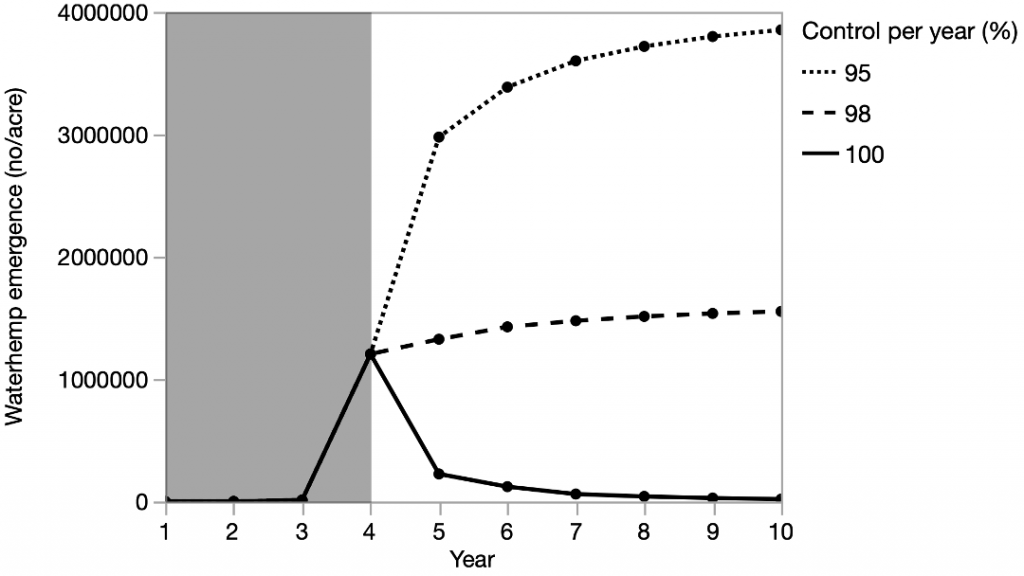
Objective 2.
This objective was primarily focused on the effects of residual herbicides on interseeded annual ryegrass, but we also rated weed control prior to post-emergence applications (Table 4). Lambsquarters control was not as effective as in 2019, possibly related to decreased rainfall, but 0.9” rain was recorded in the first ten days following application, so activation should have been achieved. Other broadleaf control was also not as effective for certain treatments, but this may reflect the inclusion of velvetleaf in this category in 2020.
Injury to the interseeded annual ryegrass was similar to the results of the previous year (Table 5). Unfortunately, the 2019 effect of cultivation seemingly reducing the injury caused by Acuron was not observed in 2020. We were surprised in both years that atrazine did not cause more injury, but it may relate to the high organic matter of the field. Overall, Callisto again offered the most effective waterhemp control in Objective 1 trials, while causing minimal injury to the interseeded annual ryegrass. However, overlapping chloroacetamides (like Dual or Harness) is a key aspect of controlling resistant waterhemp and this tactic would not be compatible with interseeding.
Immediately prior to corn silage harvest, we had nearly 90% less annual ryegrass biomass in 2020 compared to 2019. The primary difference was that in 2020 the corn was larger at interseeding and likely outcompeted the annual ryegrass. In 2020, the corn had accumulated 655 growing degree days at interseeding compared to 550 in 2019. To access growing degree day information from a weather station near you visit http://newa.cornell.edu/ .
References
Davis AS, Fu X, Schutte BJ, Berhow MA, Dalling JW (2016) Interspecific variation in persistence of buried weed seeds follows trade-offs among physiological, chemical, and physical seed defenses. Ecology and Evolution. 6:6836–6845
Heneghan JM, Johnson WG (2017) The Growth and Development of Five Waterhemp (Amaranthus tuberculatus) Populations in a Common Garden. Weed Science. 65:247–255
Acknowledgements
Thank you to the New York Farm Viability Institute for supporting this project.
Disclaimer: Read pesticide labels prior to use. The information contained here is not a substitute for a pesticide label. Trade names used herein are for convenience only; no endorsement of products is intended, nor is criticism of unnamed products implied. Laws and labels change. It is your responsibility to use pesticides legally. Always consult with your local Cooperative Extension office for legal and recommended practices and products. cce.cornell.edu/localoffices
For more information on this project, check out: https://nysipm.cornell.edu/agriculture/weed-ipm/

